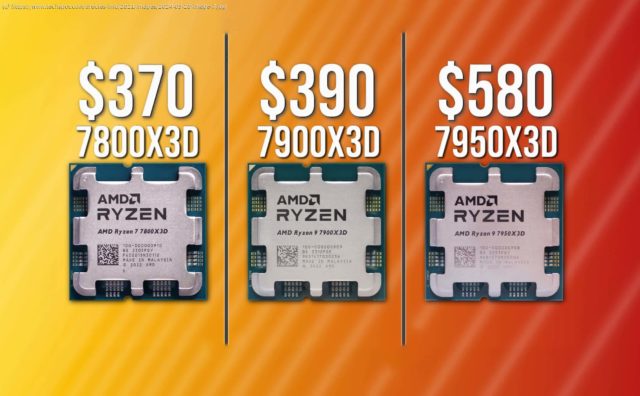With recent price changes, the Ryzen 7800X3D can now be had for as little as $370, the 7900X3D is just $20 more, and the 7950X3D is down.
We finally got around to testing the Ryzen 9 7900X3D, which was released a little over a year ago, so the timing feels right . All kidding aside, this was never a CPU we were interested in because at $600, it simply didn’t make sense. Even without reviewing it, we already knew all we needed to know given our experience with the 7800X3D and 7950X3D. Frankly, at the time, we had more interesting products to cover, but one year later and that’s no longer the case, so let’s do it.
Formerly at $600, you were better off buying the 7950X3D for $700. That mere 17% price increase gave you 33% more cores, and more crucially for gaming, you got an extra two 3D V-Cache enabled cores. Alternatively, if gaming was the focus, then the 7800X3D for $450 was not only a lot cheaper but also guaranteed to deliver better gaming performance as it packed eight 3D V-Cache enabled cores, whereas the 7900X3D is limited to just six.
With recent pricing changes, things have changed in a rather big way. The 7800X3D can now be had for as little as $370, and the 7950X3D $580, which is near enough to a 20% discount on both parts. But those aren’t the biggest discounts; the 7900X3D has seen 35% slashed off its price, dropping it to just $390, making it a mere $20 more than the 7800X3D.
This is having many prospective Ryzen buyers reconsider the 7900X3D. The only problem is there’s very little benchmark data online as this part never had a review program. So, we went and got one, and then threw our battery of gaming benchmarks at it, to see how it compares against the 7950X3D and 7800X3D, but also the rest of the Ryzen 7000 series.
For testing, we’re using the Gigabyte X670E Aorus Master motherboard running the latest F22 BIOS, and for the memory, we have a 32GB DDR5-6000 CL30 kit. For the GPU, we’re of course using the GeForce RTX 4090 as it’s the best tool for measuring the gaming performance of CPUs, and this means we’ll also be testing at 1080p.
If you’re wondering why reviewers test this way and you’d like to learn more, we have an explainer that covers that. Now let’s get into the data…
First up is Baldur’s Gate 3, which has been an excellent title for the X3D chips. The 7800X3D, for example, is 52% faster than the 7700X in this game. However, while the non-3D V-Cache parts are quite similar in terms of performance, the faster X3D variants show more variance in the results. The 7800X3D and 7950X3D delivered similar performance, but the 7900X3D was slightly slower, trailing by a 7% margin.
This is because it has fewer 3D V-Cache enabled cores, just six rather than eight, and the game is configured to only run on the 3D V-Cache enabled cores. Out of curiosity, we disabled the non-3D V-Cache CCD on the 7900X3D, creating what would be a 7600X3D if such a part existed, and doing so further reduced performance, presumably because the second CCD was being used to handle background tasks, or really anything not related to Baldur’s Gate 3. Even so, a 7600X3D would still be almost 30% faster than the 7950X in this game.
Moving on to Cyberpunk 2077: Phantom Liberty, we start to see some examples of why it’s difficult to predict the performance of these processors. The dual CCD design of the 7950X3D costs it some performance here, as the 7800X3D is up to 6% faster. However, reducing the 3D V-Cache core count to six further reduces performance, as here the 7900X3D was good for 171 fps, making it 12% slower than the 7800X3D. But if we disable the second CCD on the 7900X3D, effectively creating a 7600X3D, performance actually improves by 6%, as we’re no longer paying a penalty for cross-CCD communication, and those additional slower cores aren’t useful in this title.
Essentially, for maximum performance, you want eight 3D V-Cache enabled cores, and ideally, you want them all within the same core complex due to scheduling not being perfect.
Next, we have Hogwarts Legacy, where performance does improve with additional cores, albeit not significantly. However, we are seeing better performance with the 7900X3D and 7950X3D over the 7800X3D, for example, and the simulated 7600X3D is slower again.






